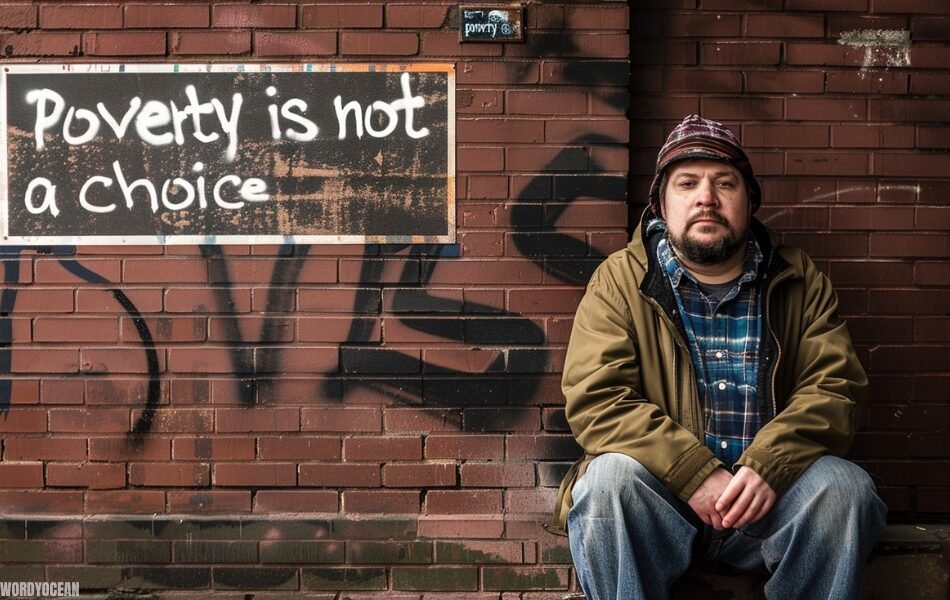Why Poverty Is Like a Disease by Cooper Audience

Poverty, a relentless affliction, casts a long shadow over countless lives. It’s not merely a lack of material possessions; it’s a systemic condition, a disease that saps strength, stifles dreams, and perpetuates itself across generations. Cooper’s audience, composed of individuals with a keen eye for social justice and a desire to make a difference, understands the insidious nature of poverty. They recognize that it’s a multifaceted issue with roots deeply embedded in economic, social, and political systems.
Why poverty is like a disease by cooper audience. It’s a silent epidemic, often hidden beneath layers of neglect and indifference. Yet, its symptoms are unmistakable: malnutrition, poor health, limited education, and social isolation. These symptoms, like those of a physical illness, can worsen over time, leading to devastating consequences.
To truly understand the gravity of poverty, one must delve into its root causes. Economic inequality, unemployment, and lack of access to quality education are just a few of the factors that contribute to this complex issue. Moreover, systemic biases and discriminatory practices can further exacerbate poverty, trapping individuals and families in a cycle of deprivation.
The Devastating Symptoms of Poverty
Poverty, a silent epidemic, manifests itself in a myriad of ways, both physical and psychological. Its symptoms, often insidious and far-reaching, can have a profound impact on individuals and communities alike.
One of the most visible symptoms of poverty is malnutrition. Lack of access to nutritious food can lead to stunted growth, weakened immune systems, and a host of other health problems. Moreover, poverty often limits access to quality healthcare, resulting in untreated illnesses, chronic conditions, and premature death. The poor are disproportionately affected by infectious diseases, as they lack the resources to prevent and treat these illnesses.
The psychological toll of poverty is equally devastating. Chronic stress, anxiety, and depression are common among those living in poverty. The constant worry about basic necessities, such as food and shelter, can take a significant toll on mental health. Additionally, poverty can limit educational opportunities, hindering cognitive development and reducing future prospects.
Poverty can also lead to social isolation and marginalization. Those living in poverty may be excluded from social activities and opportunities, further exacerbating feelings of loneliness and despair. Moreover, poverty can contribute to increased crime rates, as individuals may resort to illegal activities to survive. Limited access to social services, such as job training, housing assistance, and healthcare, can further perpetuate the cycle of poverty.
The Root Causes of Poverty
Poverty, a complex and multifaceted issue, is often rooted in a combination of economic, social, and environmental factors. Understanding these underlying causes is crucial to developing effective strategies for poverty alleviation.
Income inequality, a stark reality in many societies, is a significant driver of poverty. The vast gap between the rich and the poor can limit opportunities for the disadvantaged, perpetuating the cycle of poverty. Unemployment and underemployment, particularly among marginalized groups, can further exacerbate poverty. A lack of economic opportunities, such as job training and entrepreneurship support, can also hinder social mobility.
Discrimination and prejudice, based on factors such as race, gender, and ethnicity, can limit access to education, employment, and housing. This can lead to social exclusion and economic hardship. A lack of education and skills can also contribute to poverty, as it reduces individuals’ ability to secure well-paying jobs. Political instability and conflict can disrupt economic activity, displace populations, and destroy infrastructure, further exacerbating poverty.
Natural disasters, such as floods, droughts, and earthquakes, can devastate communities and push people into poverty. Climate change, with its increasingly frequent and severe weather events, can also have a significant impact on vulnerable populations.
The Vicious Cycle of Poverty
Poverty is not merely a static condition; it’s a dynamic process that can perpetuate itself across generations. This cycle of deprivation is characterized by several interconnected factors.
Limited access to resources, such as education, healthcare, and clean water, can trap individuals and families in poverty. Without these essential resources, it becomes difficult to break free from the cycle of deprivation. Intergenerational poverty, where poverty is transmitted from one generation to the next, is a stark reality for many. Children born into poverty are often denied the opportunities and resources they need to succeed, perpetuating the cycle.
Lack of social mobility, or the ability to move up the socioeconomic ladder, is another key factor in the perpetuation of poverty. Systemic barriers, such as discrimination and lack of access to quality education, can limit the opportunities for individuals to escape poverty.
To break the cycle of poverty, it is essential to address its root causes. Investing in education and healthcare can equip individuals with the skills and knowledge they need to succeed. By providing access to quality education, governments can empower individuals to break free from the cycle of poverty.
Creating job opportunities is another crucial step in poverty alleviation. By investing in job training programs and supporting small businesses, governments can create a more inclusive and equitable economy. Providing social safety nets, such as unemployment benefits and food assistance, can help to protect vulnerable populations from falling into poverty. By addressing these interconnected factors, we can work towards a future where poverty is a thing of the past.
The Role of Cooper’s Audience in Combating Poverty
Cooper’s audience, comprised of individuals with a passion for social justice and a commitment to making a difference, has a crucial role to play in addressing the complex issue of poverty. By leveraging their unique perspectives and resources, they can contribute to a more equitable and just society.
Advocacy and activism are powerful tools for driving social change. By raising awareness about the root causes and consequences of poverty, Cooper’s audience can mobilize public opinion and inspire action. Lobbying for policy changes that address poverty, such as increased funding for social programs and progressive tax policies, can have a significant impact on the lives of millions. Supporting grassroots organizations that are working to empower communities can also help to alleviate poverty.
Philanthropy and charitable giving are essential for addressing the immediate needs of those living in poverty. Donating to poverty-focused organizations can provide critical support for essential services, such as food, shelter, and healthcare. Volunteering time and resources can also make a significant difference, whether it’s tutoring children, mentoring young adults, or providing healthcare services.
Education is a powerful tool for promoting empathy and understanding. By sharing knowledge and inspiring action, Cooper’s audience can help to create a more compassionate and informed society. Educating others about the realities of poverty can challenge stereotypes and misconceptions, fostering empathy and solidarity.
By embracing these roles, Cooper’s audience can contribute to a more just and equitable world, where poverty is eradicated and everyone has the opportunity to thrive.
Conclusion: Why Poverty Is like a Disease By Cooper Audience
In conclusion, poverty, a complex and multifaceted issue, can be likened to a disease that afflicts individuals and communities. Its symptoms, causes, and consequences are far-reaching, impacting every aspect of human life.
By understanding the root causes of poverty, such as economic inequality, social injustice, and environmental degradation, we can begin to develop effective strategies for addressing this global challenge. Investing in education, healthcare, and job training can empower individuals and communities to break free from the cycle of poverty.
Cooper’s audience, with their unique perspectives and resources, has a crucial role to play in combating poverty. By advocating for policy change, supporting grassroots organizations, and engaging in philanthropic endeavors, they can contribute to a more just and equitable world.
Let us all work together to create a future where poverty is eradicated and everyone has the opportunity to thrive. By embracing compassion, empathy, and a commitment to social justice, we can break the chains of poverty and build a brighter future for all.
FAQs: Why Poverty Is like a Disease By Cooper Audience
Q: Why is poverty compared to a disease?
A: Poverty, like a disease, is a complex condition with far-reaching consequences. It affects individuals physically, mentally, and socially. It can be transmitted across generations, and its symptoms can worsen over time.
Q: What are the main symptoms of poverty?
A: Poverty manifests in various ways, including physical, mental, and social symptoms. Physically, it can lead to malnutrition, poor health, and increased vulnerability to disease. Mentally, it can cause stress, anxiety, depression, and cognitive impairment. Socially, it can result in isolation, marginalization, and limited access to resources and opportunities.
Q: What are the root causes of poverty?
A: Poverty is often rooted in a combination of economic, social, and environmental factors. Economic factors, such as income inequality, unemployment, and lack of economic opportunities, can contribute to poverty. Social factors, including discrimination, lack of education, and political instability, can also exacerbate poverty. Environmental factors, such as natural disasters and climate change, can further exacerbate poverty, especially in vulnerable communities.
Q: How does poverty perpetuate itself?
A: Poverty can perpetuate itself through several mechanisms. Limited access to resources, such as education, healthcare, and clean water, can trap individuals and families in poverty. Intergenerational poverty, where poverty is transmitted from one generation to the next, can further perpetuate the cycle. Additionally, lack of social mobility can limit opportunities for individuals to escape poverty.







